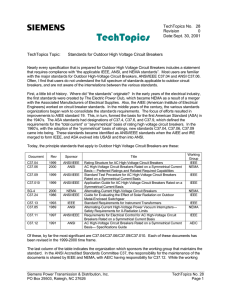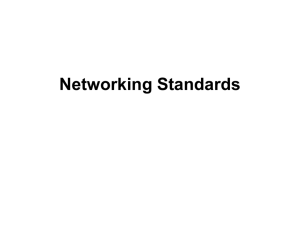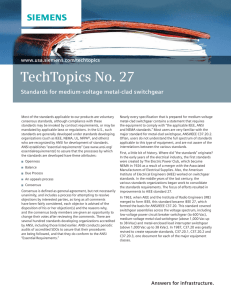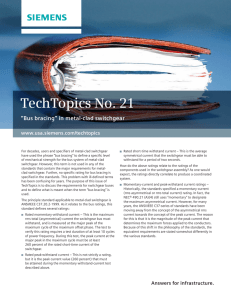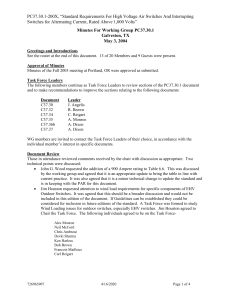TechTopics No. 28 Standards for outdoor high-voltage circuit breakers www.usa.siemens.com/techtopics
advertisement
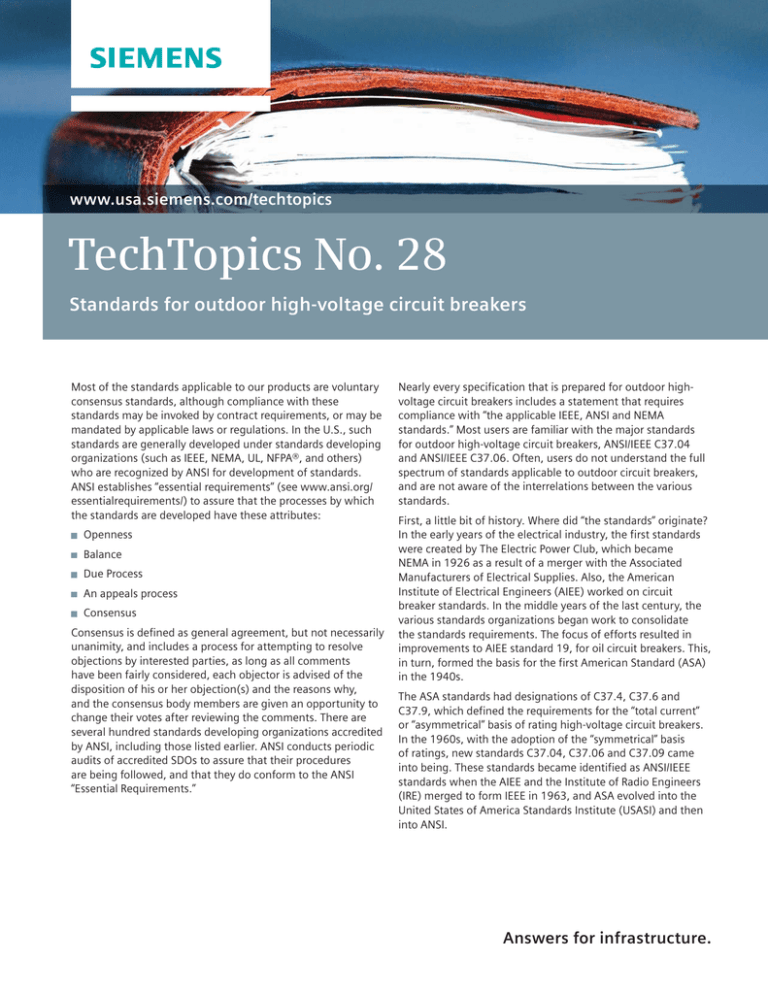
www.usa.siemens.com/techtopics TechTopics No. 28 Standards for outdoor high-voltage circuit breakers Most of the standards applicable to our products are voluntary consensus standards, although compliance with these standards may be invoked by contract requirements, or may be mandated by applicable laws or regulations. In the U.S., such standards are generally developed under standards developing organizations (such as IEEE, NEMA, UL, NFPA®, and others) who are recognized by ANSI for development of standards. ANSI establishes “essential requirements” (see www.ansi.org/ essentialrequirements/) to assure that the processes by which the standards are developed have these attributes: O penness B alance D ue Process A n appeals process C onsensus Consensus is defined as general agreement, but not necessarily unanimity, and includes a process for attempting to resolve objections by interested parties, as long as all comments have been fairly considered, each objector is advised of the disposition of his or her objection(s) and the reasons why, and the consensus body members are given an opportunity to change their votes after reviewing the comments. There are several hundred standards developing organizations accredited by ANSI, including those listed earlier. ANSI conducts periodic audits of accredited SDOs to assure that their procedures are being followed, and that they do conform to the ANSI “Essential Requirements.” Nearly every specification that is prepared for outdoor highvoltage circuit breakers includes a statement that requires compliance with “the applicable IEEE, ANSI and NEMA standards.” Most users are familiar with the major standards for outdoor high-voltage circuit breakers, ANSI/IEEE C37.04 and ANSI/IEEE C37.06. Often, users do not understand the full spectrum of standards applicable to outdoor circuit breakers, and are not aware of the interrelations between the various standards. First, a little bit of history. Where did “the standards” originate? In the early years of the electrical industry, the first standards were created by The Electric Power Club, which became NEMA in 1926 as a result of a merger with the Associated Manufacturers of Electrical Supplies. Also, the American Institute of Electrical Engineers (AIEE) worked on circuit breaker standards. In the middle years of the last century, the various standards organizations began work to consolidate the standards requirements. The focus of efforts resulted in improvements to AIEE standard 19, for oil circuit breakers. This, in turn, formed the basis for the first American Standard (ASA) in the 1940s. The ASA standards had designations of C37.4, C37.6 and C37.9, which defined the requirements for the “total current” or “asymmetrical” basis of rating high-voltage circuit breakers. In the 1960s, with the adoption of the “symmetrical” basis of ratings, new standards C37.04, C37.06 and C37.09 came into being. These standards became identified as ANSI/IEEE standards when the AIEE and the Institute of Radio Engineers (IRE) merged to form IEEE in 1963, and ASA evolved into the United States of America Standards Institute (USASI) and then into ANSI. Answers for infrastructure. Today, the principle standards that apply to outdoor highvoltage circuit breakers are these: Document Rev. Sponsor C37.04 1999 ANSI/IEEE Rating Structure for AC High-Voltage Circuit Breakers C37.06 2009 ANSI/IEEE C37.09 1999 ANSI/IEEE Standard Test Procedure for AC High-Voltage Circuit Breakers Rated on a Symmetrical Current Basis IEEE C37.010 1999 ANSI/IEEE Application Guide for AC High-Voltage Circuit Breakers Rated on a Symmetrical Current Basis IEEE SG4 2009 C37.24 2003 ANSI/IEEE Guide for Evaluating the Effect of Solar Radiation on Outdoor Metal-Enclosed Switchgear IEEE C57.13 2008 ANSI/IEEE Standard Requirements for Instrument Transformers IEEE C37.85 2002 ANSI/IEEE Alternating-Current High-Voltage Power Vacuum Interrupters – Safety Requirements for X-Radiation Limits C37.11 1997 ANSI/IEEE Requirements for Electrical Control for AC High-Voltage Circuit Breakers Rated on a Symmetrical Current Basis IEEE C37.12 2008 ANSI/IEEE AC High-Voltage Circuit Breakers Rated on a Symmetrical Current Basis – Specifications Guide IEEE NEMA Title AC High-Voltage Circuit Breakers Rated on a Symmetrical Current Basis – Preferred Ratings and Related Required Capabilities for Voltages above 1000 V Alternating-Current High-Voltage Circuit Breakers Of these, by far the most significant are C37.04, C37.06, C37.09 and C37.010. Each of these documents has been revised in the 1999 to 2000 time frame (and again in 2009 for C37.06). The last column of the table indicates the organization that sponsors the working group that maintains the standard. Accredited Standards Committee (ASC) C37 sponsors the standard C37.85, which specifies X-radiation limits and methods of determination for vacuum interrupters. The working group for this document is a NEMA technical committee. The voting representation within ASC C37 conforms to the ANSI requirements for balanced representation. Equal delegations represent IEEE, NEMA and the Electric Light & Power (users) group, represented by the Edison Electric Institute. Various other organizations also have voting representatives, including representatives of testing organizations, installation contractors, government entities and the like. The procedures of ASC C37 assure that no one interest group (producers, users or general interest) has the ability to dominate the process of creation or approval of the standards. Working group IEEE IEEE NEMA NEMA The list of standards above is not all-inclusive, but does include the major standards. There are others that apply, such as those for protective relays, device numbers and the like. It is interesting to note that only one NEMA standard, SG4, is listed. For the most part, IEEE and NEMA have cooperated over several decades to incorporate the applicable sections of the historic NEMA standards into the relevant ANSI/IEEE or ANSI documents. NEMA SG4 was revised in 2009 to address those issues not covered adequately in the ANSI/IEEE standards. The major areas covered in SG4 are RIV testing, sound levels, special applications (arc furnaces), terminal configurations, current transformer installation and wiring requirements, as well as installation and maintenance recommendations. Most of the information in SG4 2009 has been offered to IEEE for inclusion in presently active revisions of C37.04 and C37.09. The material formerly in NEMA SG4 that was not transferred to IEEE has been moved to a new publication, SG11. This information primarily concerns maintenance of historic outdoor circuit breakers. Over the years, major strides have been made in harmonizing the requirements of the ANSI/IEEE standards with the requirements of the IEC standards (primarily IEC 60056, which has recently been re-identified as IEC 62271-100). Over the next few years, working groups within the High-Voltage Circuit Breakers Subcommittee of the IEEE Switchgear Committee will be working to further harmonize with the international standards. Siemens does not take a position as to the proper applicability of any particular standards over other accepted standards. We design and manufacture our products with primary concern for the safety of our customers and users, regardless of applicable standards. Siemens makes no warranties or guarantees of compliance with any standards except by specific contractual relationship with our customers and as marked on the products themselves when delivered from the manufacturer. The information provided in this document contains merely general descriptions or characteristics of performance which in case of actual use do not always apply as described or which may change as a result of further development of the products. An obligation to provide the respective characteristics shall only exist if expressly agreed in the terms of contract. All product designations may be trademarks or product names of Siemens AG or supplier companies whose use by third parties for their own purposes could violate the rights of the owners. Siemens Industry, Inc. 7000 Siemens Road Wendell, NC 27591 Subject to change without prior notice. Order No.: E50001-F710-A317-X-4A00 All rights reserved. © 2012 Siemens Industry, Inc. For more information, contact: +1 (800) 347-6659 www.usa.siemens.com/techtopics
